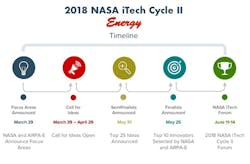What are Your Energy Ideas to Enhance Space Exploration and Life on Earth?
NASA iTech and the U.S. Department of Energy’s Advanced Research Projects Agency-Energy (ARPA-E) are collaborating on a unique iTech competition to identify transformational energy technologies that can improve energy generation, storage, and distribution to the benefit both space exploration and life on Earth.
For the 2018 iTech Energy Cycle, NASA and ARPA-E are seeking to identify the nation’s top entrepreneurs and researchers to present their innovative technologies to address energy-specific challenges. A few examples of technology sub-themes that NASA believes have the potential to improve future space power systems include, but are not limited to:
- Fuel cells and regenerative fuel cells
- High-energy density batteries and supercapacitors
- Solar-power systems
- Small fission-power systems
- Innovative power management and distribution (including smart grids and wireless power transfer)
- X-factor energy—innovations so compelling that NASA and ARPA-E should know about them
"Although this is not a typical Cycle, NASA iTech has proven to be a successful public-private partnership model for stimulating the development of groundbreaking technologies, without the government being the early investor,” said Kira Blackwell, NASA iTech program executive in the Space Technology Mission Directorate at NASA Headquarters in Washington.
This is the proposed timeline of the initiative (subject to change).
Already underway and continuing through April 29, 2018, inventors and entrepreneurs can submit a five-page white paper on their concept on the NASA iTech website. A panel of subject matter experts from NASA and ARPA-E will review ideas submitted and select the top 10 finalists based on their relevance and potential impact.
“The finalists have an opportunity to present their technologies and engage with NASA and ARPA-E subject matter experts, potential investors, and industry partners,” said Blackwell. “NASA is pleased to see an increased interest from the private sector by having Citi [bank] facilitate inclusion of a broad range of energy investors and corporate energy experts to assist in the competition process. Citi will also host the final round of coaching and judging at Citi’s global headquarters in New York City from June 11-14.”
“Citi is honored to support NASA iTech with this effort to crowdsource innovative and sustainable energy solutions that solve space exploration challenges as well as energy challenges here on earth,” said Jay Collins, Vice Chairman of Corporate and Investment Banking at Citi.
ARPA-E provides R&D funding for transformational ideas to create America’s future energy technologies. It focuses exclusively on early-stage technologies that could fundamentally change the way we generate, use, and store energy.
NASA iTech is an initiative sponsored by NASA’s Space Technology Mission Directorate and managed by the National Institute of Aerospace in Hampton, Virginia.
For information about the NASA iTech initiative, visit http://www.nasa.gov/directorates/spacetech/itech
About the Author

Sam Davis
Sam Davis was the editor-in-chief of Power Electronics Technology magazine and website that is now part of Electronic Design. He has 18 years experience in electronic engineering design and management, six years in public relations and 25 years as a trade press editor. He holds a BSEE from Case-Western Reserve University, and did graduate work at the same school and UCLA. Sam was the editor for PCIM, the predecessor to Power Electronics Technology, from 1984 to 2004. His engineering experience includes circuit and system design for Litton Systems, Bunker-Ramo, Rocketdyne, and Clevite Corporation.. Design tasks included analog circuits, display systems, power supplies, underwater ordnance systems, and test systems. He also served as a program manager for a Litton Systems Navy program.
Sam is the author of Computer Data Displays, a book published by Prentice-Hall in the U.S. and Japan in 1969. He is also a recipient of the Jesse Neal Award for trade press editorial excellence, and has one patent for naval ship construction that simplifies electronic system integration.
You can also check out his Power Electronics blog.


